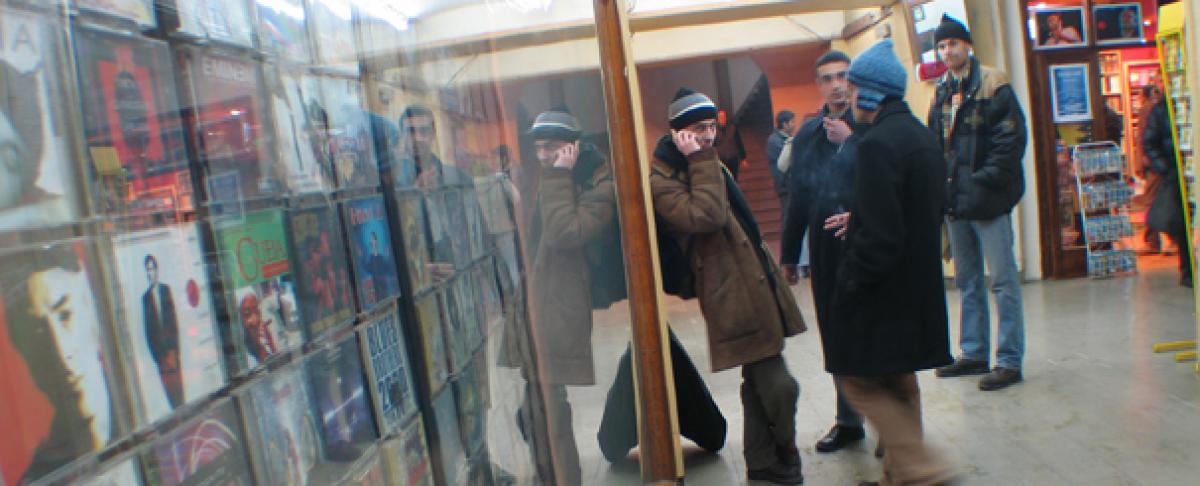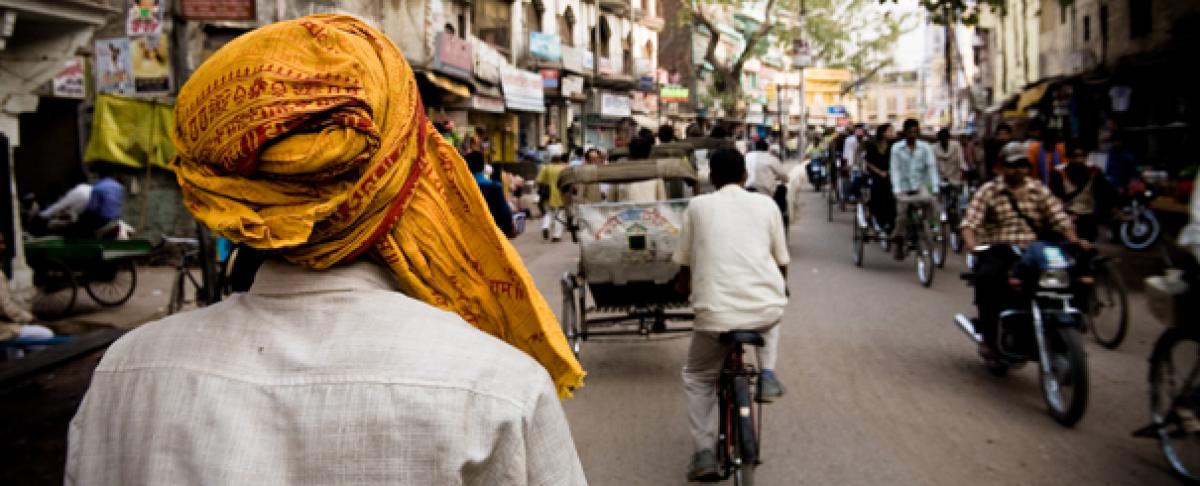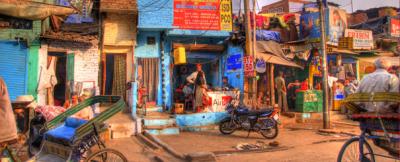
Art Cannot Be not Political
Speaking about «marginalised regions» always implies a specific position or perspective: there are parts of our world more central than others. By focussing on the Balkans as «marginalized», I assert that other regions like Western Europe or North America are more central. This can be understood from a purely economic point of view with the Balkans losing its importance after the end of the communist regimes in Eastern Europe due to the global centralisation of economic power known as «globalisation». The following essay tries to connect the economic and cultural situation with the role of the arts.
«Culture» in this context is understood as general behaviour of society whereas «art» is its specific creative expression in a (fictional or real) public space in order to reflect it. I speak namely about visual and performing arts, about cinema and literature, theatre and music. They are all involved in social public reflection on different levels.
There is worldwide interest in artistic products stemming from the Balkans, especially from the new countries of Former Yugoslavia. The numerous festivals and expositions focussing on this region as their topic are evidence of this. One of the most powerful expositions was Harald Szeemann’s Blood and Honey (2003). More popular and widely known are the movies crowned by international awards such as Underground by Emir Kusturica (Golden Palm at Cannes Film Festival 1995), No Man’s Land by Danis Tanovic (Oscar® for Best Foreign Film 2001), Grbavica by Jasmila Zbanic (Golden Bear at Berlin International Film Festival 2006), or Das Fräulein by Andrea Staka (Golden Leopard at Locarno International Film Festival 2006). At the same time, the novels of Nobel Prize winner Ivo Andric and others like Aleksandar Tisma have been republished. The success of the visual arts and literature contrasts with music, which was very much abused during the wars in the 90s. The same folk melodies were used by the different sides, with a different text and war criminals claimed the epic tradition of gusla players as their own background: «Croatian rebel-heroes in the Bosnian war are shown as people in whose veins runs the blood of old Herzegovinian hayduks. Tuta [a nicknamed war criminal] experienced the honour of a song in heroic decasyllabic metre being dedicated to him, being praised in the media as a contemporary offspring, or even a distant descendant of the famous hayduk Mijat Tomic.» (Ivan Colovic 2004, 259)
The creation of new music in this space is contaminated by a culturally spoiled tradition. The use of traditional musical elements has to be more reflected than elsewhere because their risk of abuse by certain nationalistic tendencies is still great. We have to ask ourselves why the Balkans as a region disappeared during the Cold War period till the new conflicts woke us in 1991: And why this region is so interesting culturally – especially in the visual arts – whereas it rests marginalised in the field of music and in politics. It needs to be pointed out that the most abstract art and music relates strongly to politics.
After the entry of Bulgaria and Romania into the European Union, the war affected countries of Bosnia and Herzegovina, Croatia, Kosova, Macedonia and Serbia form a blind spot within Europe. This is not only to do with the heavy economic situation, but is also the result of cultural stigmatisation that goes back to the first and second Balkan Wars in the beginning of the 20th century. The Balkans cultural impacts from and on Europe are changing and are dependent on the historical period. With the occupation of Bosnia by the Habsburg Monarchy in 1878 a lot of German speaking travellers and colonisers invaded «their own orient». There was an increase in production of travel guides and ethnological approaches, but also of literary texts in order to describe Bosnia as part of this Europe oriented monarchy. They forged more and more categories, which shifted softly to stigmatisations (Todorova 1994, 453–482). A comic journalistic example illustrates this point in the editorial part of an American newspaper. It discusses the assassination of Serbian King Aleksander Obrenovic and his wife Draga – focussing on the fact that they have been thrown from a window of their palace – it points out to readers (who were presumed not to know a lot about the Balkans) that «undoubtely there is something in the Slavic nature which predisposes those of Slav blood to throw […] an enemy to become an angel». The opening of the window and throwing one’s enemy out, claims the newspaper, «is a racial characteristic» which is contrasted to those of other Europeans. It concludes however this phenomenon «may be attributed to a primitive Slavic strain» (The New York Times, 24 June 1903, 8). At the same time «Europe» added «balkanization» to its repertoire of swearwords, which proved to be more lasting than a lot of older notions. «Balkanization» not only designates the parcelling of bigger political units but is also a synonym for reversion to the barbaric and primitive (Todorova: 1997, 17).
After the cesura of the Cold War, with the first conflicts in Former Yugoslavia, it was especially the literary perception of the Balkans that took up this specific stigmatisation, mostly in paratexts, which just tell the opposite of the literary text itself. On the cover of Milo Dor’s reprinted novel Schüsse in Sarajevo (Shooting in Sarajevo) in 1989 is written that the exciting assassination story of 1914 shows us that Bosnia was a «powder keg» before World War I and is still one – even though the author of this book proves that the beginning of World War I was instigated by Austria which forced Serbia to enter. In the German text collection Terra Bosna of 2002, the short story by the Nobel Prize Winner Ivo Andric The Letter from 1920 (Pismo iz 1920. godine) gets the subtitle «The land of fear and hatred – A Letter from Bosnia» even though the doctor Max Löwenfels does not write this letter to the narrator from Bosnia, but from Trieste. However, he does speak there about subliminal hatred in Bosnia; therefore he migrated to Paris. Although the narrator adds «Non est salus nisi in fuga» («There is no salvation in flight», Andric 2002, 99), as he had just arrived in 1938 during the Spanish Civil War in a town in Aragonia where he worked in a military hospital. There, he was a target of a bombing where he died with all his patients. The conclusion of the narrator: «In this way ends the life of a man who fled from hatred.» If the short story of Ivo Andric tries to show something then it is the opposite of that which the German perception asserts: In 1920, just after the forming of the new kingdom of Serbia, Croatia and Slovenia, you can find hatred in Bosnia, but at the same time this year marks an end of the Balkans’ civil wars of the 10s. But – and this is important – you can find hatred in much more deadly forms in other parts of Europe in 1938. The last example stems from the English Newspaper Belgrade Times of 8 October 2006. The article «Through Bosnia and Herzegovina on foot during the insurrection» speaks about the classic 19th century travel diary by Arthur Evans by showing the fact that the author «tended to underline what united the different ethnic groups in Bosnia, making references either to local examples or to more regional aspects, whereas other authors placed great weight on what separated them». Different examples are made and the article ends with a hopeful passage: »The existence of a common cultural background shared by different ethnic groups does emerge from the account.» (21) But what really attracted the reader’s eyes to this article is not this message, but just the opposite: «Seen through the eyes of a foreigner, nineteenth-century Bosnia-Herzegovina inevitably assumed the features of a land pervaded by ethnic hatred, social injustice and religious intolerance.» As long as this kind of foreground perception is propagated, the Balkans is linked with stereotypes like barbarism, violence and hatred; although totalitarian regimes and even the United States have «produced» many more human victims in their history. (Todorova 2004, 8). We have to acknowledge that it is difficult to compare war crimes. But we have to think about how cultural marginalisation can be reduced by alternative artistic practice. The following reflections will focus on this question by examining some specific examples.
One year before war in 1990, you could buy empty but closed tins sold by the national party HDZ of Tudjman in Zagreb. Inscribed on these tins was: «Cisti hrvatski zrak» – «Clean Croatian Air». It was understood as a running gag, but what followed was the beginning of the «ethnic cleansing» in 1991. If this tin could had been exposed and reflected on in an artistic framework, it would have shown the paradox between «stinky» enclosed air and its name, and by extension, how ridiculous the project of this party was. What could have been useful, was sacrificed to a dangerous nationalistic discourse. Art has first to say something which is political, otherwise it is not art. This has nothing to do with to what degree art declares itself as political. It is meant in an intrinsic sense – which concerns even art that denies political implication. In such a dialectic framework, art cannot be not political. However, there is a distinction between kitsch, abused and free art. Kitsch serves only the leading power by reproducing its manifestations whereas abused art testimonies its surviving power (as can be observed for example in Shostakovich’s 5th symphony). Art – in opposition to kitsch – is political in the sense that it always stands at a critical distance to power.
A further example of unreflected cultural behaviour can be seen on the highway from the capital of Croatia to Belgrade, where there is no indication of your next urban destiny. Instead of the capital of Serbia, you only see the name of Lipovac, the last little Croatian village before the border. This confusion can result in being trapped in the province. Serbia must be ignored because it is not civilised according to the Croatian nationalistic discourse. A similar stigmatisation can be found in Serbia towards the Muslims of Bosnia, and in the whole Balkans towards the Albanians. (Bakic-Hayden 1995, 928) The stigmatisation from the West is accepted and forwarded to the next neighbour. But as long as the background of these practices remain concealed, nationalism can expand. It is not sufficient to support the economy in exchange for war criminals. It is necessary to know about the context of cultural phenomena and to deconstruct them by specific artistic means in order to understand and resolve the real problem.
As I have illustrated, the «nesting orientalisms» result from the Western perception of the Balkans. Balkans nationalism is intimately connected with Western culture. This is demonstrated in Aleksandar Hemon’s novel Nowhere Man. The American, Owen—looking for somebody who knows the Serbo-Croatian language—asks the origin of Pronek, the main protagonist in this book: «What are you? […] It’s Serbs fighting Muslims over there, right? Are you Serb or Muslim?» – «I am complicated.» (Aleksandar Hemon 2003, 146) The question about culture and identity gets worse where the Balkans are concerned, as in the above extract from a novel written by an author who quitted Sarajevo in 1992 and emigrated first to Kiev before leaving for Chicago. The Western view on the events in the Balkans continues in the details: «over there» is always the other, the negation of the proper or self.
Dubravka Ugresic, who was forced to leave Zagreb during the Tudjman period, sharpens the gaze on the border between «east» and «west», between «occident» and «orient» by analyzing the formal structure of Dubravka Oraic’s palindromic poem «Rim ili mir / ili / ono» (»Rome and peace / or / it»), where the narrator describes all cruelties from Antiquity to the present, ending in the bombing of Zagreb in an apocalyptic Cassandra like vision. Dubravka Oraic published the poem in 1981, ten years before the fatal palindromic year of 1991, which marks the beginning of the wars in Former Yugoslavia. In this novel there is not only a convergence of poetical fiction and reality, but something even more exciting: The palindromic structure treats the function of the border by unmasking the other discourse as identical. There is no importance placed on whether the discourse comes from Serbia or Croatia, but it is significant that they both have the same structure. Paradoxically this culminates in Former Yugoslavia, where the languages are very similar. You can name them Bosnian, Croatian, Serbian or even Montenegrin, they remain the same.
To return to Nowhere Man: Pronek finally gets the job as translator because he masters the Montenegrin-Croatian-Serbian-Bosnian language. His first task consists in bringing a letter to a Serb. He talks with him in the lingua franca, in English. He says that he is originally from Ukraine (which is not so false … though he is born in Sarajevo). Therefore the «orthodox brother» welcomes him warmly, and Pronek achieves his task successfully – although he must keep quiet about his «other brothers» left in Sarajevo, occupied by the Yugoslavian Army and Serbian Paramilitary. Language always produces questions around origin and identity. However, it does not resolve such questions. What has the exile situation in the United States to do with this discourse about the other and the self? It is the mirror of reflection which Dubravka Ugresic evokes in My American Fictionary. She describes the parallels between American and Balkan culture with the culmination: «While here [in America], they are building the myth of the terrible Balkans (reality does not show the opposite), the American myth continues to exist down in the Balkans! The Balkan existence does not want to identify itself with its own image, it prefers the American! The slangy expression for knife is «rambo», the Croatian soldiers wear headbands like Sylvester Stallone, the city of Knin is called Knin Peaks and the Serbian paramilitary groups Kninjama. Reality is not only written down in new songs in epic style, but also in the typical American genre of comics. Murderers like the Serbian captain Dragan are the heroes of today’s comic; in the hand the knife and on his feet – Reebok tennis shoes! In the Belgrade slang, Belgrade is called Arkansas. Arkan is the name of a gangster…» (Dubravka Ugresic 1994, 91–92)
The specific feature of former Yugoslavian discourse consists in its metonymic function as a pars pro toto for a worldwide discourse of terrorism and against terrorism. The cultural heritage of the last twenty years in Yugoslavia shows us the consequences of such discourse. To illustrate, there is a joke in the Balkans: A man coming back from America to the Balkans is asked by his friend how it has been there. His answer: «They are really backward. They live there now as we did thirty years ago.» This joke only functions because it rests ambiguously and shows that a certain view cannot be better than the other. This is another perspective – also necessary in the Western discourse. If the structure of the other is the same, we have to find new differentiations which are more complex than the simple identification «Are you Serb or Muslim?» At this point, art begins, at a point where we get the answer: «I am complicated».
After the Olympic Games in 1984 in Sarajevo, when Yugoslavia was staged as a vivid united country for the last time, other discourses emerged: In 1986 a draft of the Memorandum of the Serbian Academy of Sciences and Arts was published. It was not nationalistic in itself but subsequently appropriated by nationalists, whereas in Croatia and Slovenia, the intellectual discourse focused on Central Europe as the new paradigm (Patterson 2003). Both created the centrifugal forces that ripped up Yugoslavia. The beginning was on both sides in the small world of the Academy. At the same time, there was a shift from a modern to a postmodern intellectual culture. The modern model of progress – bound to the idea of the everlasting communist party – was replaced by a postmodern «everything goes» ideology which postmodern thinkers themselves denied. Postmodern philosophy is not systematic but a conversatio perennis, and therefore consciously marginal but necessary in order to show the relativity of each discourse. In the isolation of the Balkans, this marginal discourse was misinterpreted as central. The result consisted in a cesura which made impossible a normal transition to a democratic system. This cesura created a space for propagandistic nationalistic culture, which was sold as postmodernistic.
Especially in the field of music, retro style was characterised as brand new. There is no difference between turbofolk and new romantic or neoclassical «new music». The only music officially supported in the Balkan region was a music which formed new myths in order to create the «great story» of the nation, although Jean-François Lyotard, the second thinker of postmodernism, propagated the «délégimitation [des] grands récits du 19ème siècle» (Lyotard 1979, 63) in order to show there is no more metadiscourse. Even today, creation of national myths continues, as it did in the 19th century. Nationalistic discourse is very European in this framework. The free space for artistic production and cultural reflection has not yet been created that would be necessary for the fertile social development of this region. This not only requires a cultural memory without censorship and archive, but also a tradition which looks for new ways of artistic expression as a reflection of cultural creation. But these bases were destroyed in the Balkans on a large scale. The first targets during the siege of Sarajevo were the National Library, the National Gallery and the Olympic Museum. This shows how systematic the efforts were to erase the culture of the other. However, the besiegers forgot it was also their own culture they destroyed, their own limbs they amputated. Cultural reconstruction has nothing to do with development aid – as it is understood normally – but is an attempt to reconnect the lost limbs with the body by recontextualising them socially and historically.
The phenomenon of intellectual and artistic «brain drain» did not stop after the wars and is still in an acute form. This has primarily to do with the fact that cultural life has not developed: in the theatre you can only see national heroes, the Philharmony plays only light music, and turbofolk is played in 90 percent of the discos. New progressive music and theatre is only performed at festivals. The argument from both sides, from the local politicians and the development aid workers, is always the same: you should not put pressure on a generation which has just survived war with new complicated art. It is true the population of Sarajevo changed during and after the war to a high degree from an urban to a rural composition. But this is not an argument to further mediocrity. I experienced in the framework of SONEMUS (Society of New Music Sarajevo, which tries to develop new music in the whole Balkans) that new progressive music and theatre finds bigger interest than in «our» countries. Most of the people who fill big halls in the city are predominantly under 20 years of age. But such initiatives are rarely supported by the local goverment of the state, province or municipality. Financal aid comes, and has to come, mainly from international organisations. In order to reverse or at least to curtail the brain drain, investments should increase greatly in order to support these special initiatives which are politically thought-provoking. At the same time, they should be linked to progressive education programs.
Cultural «development» in a critical sense connects with the Balkans because the explanations for the conflict were mainly cultural, rather than globally strategical or economic. The conflict itself was not cultural, but political. This distinction is very important and also involves arguments, which reflect the stigmatisation of the Balkans, as it was the main feature of the conflict in the form of internal «nesting orientalisms». The metropolis gets province within an idealogical misunderstanding of postmodernism. In order to understand something you reduce complexity, but if it is too big, the problem becomes incomprehensible by reducing it. Even today, the enthusiasm for new visual arts from the Balkans, results in too much reduction in order to explain the conflict in the middle of Europe.
The Balkans are the blind spot of Europe. Visual arts are necessary, but they also conceal the real problem of the intrinsic connection between politics and non visual arts like theatre (to a certain degree) and especially music. In Bosnia, World War I started – not because of Serbia – but because of worldwide European imperialism and its political connections with the Balkans. Europe is always connected with the Balkans. The Balkans function as Europe’s bad conscience and determinant of stability. As long as the Balkans figure as a reduced psychological-cultural projection of Western desires (of exotism, orientalism or even Balkanism), not only will this region remain dangerous, but it will have impacts on our projections. There is no essential discourse about the culture in the Balkans. We are reminded by Pronek’s self-definition: «I am complicated.» This is the only truth about the Balkans and its artistic, cultural and social development. It has to do with our own reflection. We have to ask ourselves what is «contemporary». It is the reflection in the arts which allows new cultural and social development and not the other way around because contemporary, and not instrumentalised, art uncovers the connections between the other and the self.
List of References
Biography
Published on June 22, 2010
Last updated on April 11, 2024
Topics
Can a small chinese radio show about Uyghur music stand against the censorshop of the Communist Party of China? Are art residencies useful?
Does one really need the other in order to understand oneself?
How does Syrian death metal sound in the midst of the civil war? Where is the border between political aesthetization and inappropriate exploitation of death?


